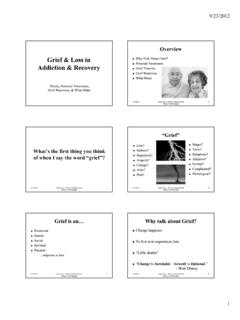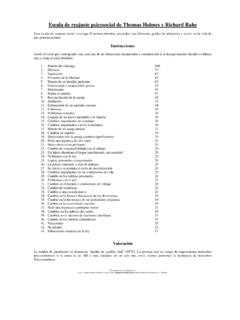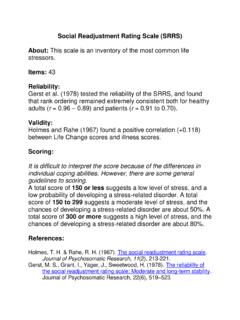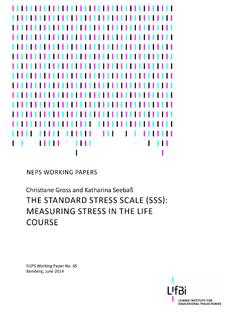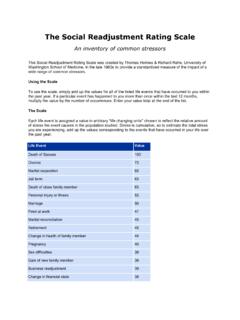Transcription of Life Events Scale - dawnfarm
1 Janice Firn, PhD, LMSW Last Updated 4/2016 Life Events Scale This stress assessment measures the amount of change, using Life Change Units, a person experienced and adjusted to in the previous 12 months. It was designed to predict the likelihood of disease and illness following exposure to stressful life Events . Each life event is given a score that indicates the amount of readjustment a person has to make as a result of the event. Not all of the Events in the Scale are necessarily negative Events . This Scale indicates that change in one's life requires an effort to adapt and then an effort to regain stability. Stress and feelings of loss are natural by-products of adapting and trying to regain homeostasis. This assessment considers only the Events that occurred, not individual perception of these Events in life. Perception is a key part of the total grief and loss experience, so while the Life Events Scale has value in increasing awareness of potential losses and life changing or stressful Events , an individual s perception of the event is an important variable which needs to be considered in the overall assessment.
2 For a more complete picture of how loss has affected a person s life consider all the dimensions of health: physical, mental, emotional, spiritual, and social. Directions For each event that occurred in your life within the past year, record the corresponding score. If an event occurred more than once, multiply the score for that event by the number of times the event occurred and record that score. Total all the scores: Score of 300+: At risk of illness. Score of 150-299+: Risk of illness is moderate (reduced by 30% from the above risk). Score 150-: Only have a slight risk of illness. A modified Scale has also been developed for students (teenagers and university aged young adults). This Scale is included in the handout. Similar to the adult Scale , life Events are totaled and provide a rough estimate of how life changes may affect health. Adapted from holmes -Rahe Social Readjustment Rating Scale . Journal of Psychosomatic Research, (1967).
3 Vol. 11, pp. 213-218. Janice Firn, PhD, LMSW Last Updated 4/2016 The Student Stress Scale The Student Stress Scale focuses on Events that may occur in the life of a student to offer you a different perspective for evaluating stress. The Student Stress Scale is an adaptation for college students of the Life Events Scale developed originally by holmes and Rahe. This popular stress assessment measured the amount of change, using Life Change Units, a person was required to adapt to in the previous year. It was designed to predict the likelihood of disease and illness following exposure to stressful life Events . Each life event is given a score that indicates the amount of readjustment a person has to make as a result of change. Some studies have found that people with serious illnesses tend to have higher scores on similar assessments. For each event that occurred in your life within the past year, record the corresponding score.
4 If an event occurred more than once, multiply the score for that event by the number of times the event occurred and record that score. Total all the scores. Life Event Mean Value 1. Death of a close family member 100 2. Death of a close friend 73 3. Divorce of parents 65 4. Jail term 63 5. Major personal injury or illness 63 6. Marriage 58 7. Getting fired from a job 50 8. Failing an important course 47 9. Change in the health of a family member 45 10. Pregnancy 45 11. Sex problems 44 12. Serious argument with a close friend 40 13. Change in financial status 39 14. Change of academic major 39 15. Trouble with parents 39 16. New girlfriend or boyfriend 37 17. Increase in workload at school 37 18. Outstanding personal achievement 36 19. First quarter/semester in college 36 20. Change in living conditions 31 21. Serious argument with an instructor 30 22. Getting lower grades than expected 29 23.
5 Change in sleeping habits 29 Janice Firn, PhD, LMSW Last Updated 4/2016 24. Change in social activities 29 25. Change in eating habits 28 26. Chronic car trouble 26 27. Change in number of family get-togethers 26 28. Too many missed classes 25 29. Changing colleges 24 30. Dropping more than one class 23 31. Minor traffic violations 20 Total Stress Score _____ Score Interpretation: Researchers determined that if your total score is: 300 or more - statistically you stand an almost 80 percent chance of getting sick in the near future. 150 to 299 - you have a 50-50 chance of experiencing a serious health change within two years. 149 or less - you have about a 30 percent chance of a serious health change. This Scale indicates that change in one's life requires an effort to adapt and then an effort to regain stability. Stress is a natural byproduct of adapting and then regaining internal homeostasis.
6 Take note that this assessment considers only the Events that occur, not individual perception of these Events in life. Perception is a critical part of the ultimate stress experience, so while the Student Stress Scale has value in increasing awareness of potential stress-producing Events , ultimately individual perception of the event is an important variable. Janice Firn, PhD, LMSW Last Updated 4/2016 Avoiding the Clich s of Grief Try open ended statements. Try to avoid telling people what they should or should not be feeling, doing, etc. Do not assume to know what someone is going through or experiencing. 1. Clich : You must be strong for your children (spouse, relatives, friends, etc). Instead, try: Why not share your feelings with your children? Perhaps you can lean on one another and help support each other. 2. Clich : You ve got to get hold of yourself. Instead, try: It must be so hard to keep going when you re hurting so much.
7 3. Clich : You are holding up so well. Instead, try: Would it help to talk about how you re feeling? 4. Clich : Time will heal. Instead, try: You must feel as if this pain will never end. 5. Clich : You re young, and you will be able to make a new life for yourself. Instead, try: You must miss your loved one and the life you had together; I do, too. What to Say What Not to Say I m sorry. I understand how you feel. I m sad for you. Death was a blessing. How are you doing with all this? It was God s will. I don t know why it happened. It all happened for the best. What can I do for you? You re still young. I m here and I want to listen. You have your whole life ahead of you. Please tell me what you are feeling. You can have other children. This must be hard for you. You can always remarry. What s the hardest part for you? Call me when I can help. I ll call tomorrow. Something good will come of this.
8 You must really be hurting. At least you have another child. It isn t fair, is it? She/he led a full life. You must really feel angry. It s time to put it behind you. Take all the time you need. Be strong! Courtesy, Archdiocese of Omaha, Family Life Office Janice Firn, PhD, LMSW Last Updated 4/2016 Rescuers Checklist Completing the checklist can help you become aware of the ways you may be rescuing people without realizing it. It is taken, with permission, from the Transactional Checklist. Mark each of the statements below as it applies to you: 0 = seldom or never; 1 = sometimes or occasionally; and 2 = frequently. X = significant others in your life such as a spouse, boss, parents, friend, or colleague. ____ 1. Is it hard for you to take time for yourself and have fun? ____ 2. Do you supply words for X when he/she hesitates? ____ 3. Do you set limits for yourself that you then exceed? ____ 4. Do you believe that you are responsible for making (keeping) X happy?
9 ____ 5. Do you enjoy lending a shoulder for X to cry on? ____ 6. Do you believe that X is not sufficiently grateful for your help? ____ 7. Do you take care of X more than you take care of yourself? ____ 8. Do you find yourself interrupting when X is talking? ____ 9. Do you watch for clues for ways to be helpful to X? ____ 10. Do you make excuses, openly or mentally, for X? ____ 11. Do you do more than your share, that is, work harder than X? ____ 12. When X is unsure or uncomfortable about doing something do you do it for X? ____ 13. Do you give up doing things because X wouldn t like it? ____ 14. Do you find yourself thinking that you really know what is best for X? ____ 15. Do you think X would have grave difficulty getting along without you? ____ 16. Do you use the word we and then find out you don t have X s consent? ____ 17. Do you stop yourself by thinking X will feel badly if you for or do something?
10 ____ 18. Is it hard for you not to respond to anyone who seems hurting or needing help? ____ 19. Do you find yourself being resented when you are only trying to help? ____ 20. Do you find yourself giving advice that is not welcome or accepted? ____ Total: More than 10 points rescuing is possible, more than 20 points rescuing is probable. Janice Firn, PhD, LMSW Last Updated 4/2016 A comparison of characteristics of both helpers and rescuers: The Helper The Rescuer 1. Listens for request 2. Presents offer 3. Gives only what is needed 4. Checks periodically with person 5. Checks results a. Functioning better? b. Meeting goals? c. Solving problems independently? d. Using suggestions successfully? 1. Gives when not asked 2. Neglects to find out if offer is welcome 3. Gives help more and longer than needed 4. Omits feedback 5. Doesn t check results and feels good when accepted, bad when turned down 6.
